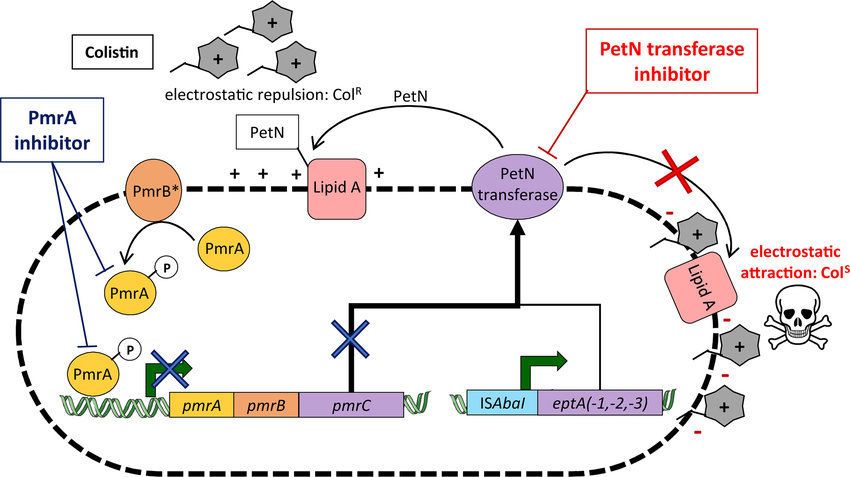𝘈𝘤𝘪𝘯𝘦𝘵𝘰𝘣𝘢𝘤𝘵𝘦𝘳 𝘣𝘢𝘶𝘮𝘢𝘯𝘯𝘪𝘪 has become a formidable challenge in clinical practice due to its resistance to multiple antibiotics, including colistin, often considered a last-resort treatment. This review delves into the mechanisms behind colistin resistance in 𝘈𝘤𝘪𝘯𝘦𝘵𝘰𝘣𝘢𝘤𝘵𝘦𝘳 𝘣𝘢𝘶𝘮𝘢𝘯𝘯𝘪𝘪 and evaluates available treatment options, including new antibiotics and synergistic drug combinations.
Key Findings:
- Mechanisms of Colistin Resistance:
- Colistin (polymyxin E) targets the outer bacterial cell membrane by interacting with lipopolysaccharide (LPS) molecules.
- Resistance mechanisms include mutations in LPS biosynthesis genes (lpxA, lpxC, lpxD), leading to altered lipid A structure or loss of LPS.
- Modifications to lipid A, such as the addition of molecules like L-Ara4N, PEtN, or galactosamine, reduce the cell membrane’s negative charge, decreasing colistin efficacy.
- Genetic alterations in pmr genes, encoding enzymes responsible for lipid A modification, contribute to resistance.
- Other mechanisms involve alterations in outer membrane permeability via porins and heteroresistance, where a minor fraction of bacterial cells within a population displays resistance.
- Available Treatments:
- New antibiotics like cefiderocol and sulbactam/durlobactam show promise, but their availability is limited.
- Combination therapy, particularly with polymyxins, ampicillin/sulbactam, carbapenems, fosfomycin, tigecycline/minocycline, rifamycins, and aminoglycosides, is crucial for overcoming colistin resistance.
- Guidelines recommend sulbactam-based regimens, with combinations including colistin, tigecycline, and cefiderocol.
- However, the optimal treatment regimen remains unclear, and continued investigation is essential.
Detailed Key Findings:
- Colistin primarily disrupts bacterial cell membranes through interactions with LPS molecules.
- Resistance mechanisms include mutations in LPS biosynthesis genes, alterations in lipid A structure, and modifications like L-Ara4N or PEtN addition.
- Genetic alterations in pmr genes and other non-lpx proteins contribute to resistance by modifying lipid A or affecting outer membrane permeability.
- Combination therapy with new antibiotics like cefiderocol and sulbactam/durlobactam, along with synergistic drug combinations, is crucial for overcoming colistin resistance.
- Guidelines recommend sulbactam-based regimens, but the optimal treatment regimen remains uncertain, highlighting the need for further research.
This underscores the urgent need for effective treatment strategies against colistin-resistant 𝘈𝘤𝘪𝘯𝘦𝘵𝘰𝘣𝘢𝘤𝘵𝘦𝘳 𝘣𝘢𝘶𝘮𝘢𝘯𝘯𝘪𝘪 infections and emphasizes the importance of continued research to address this escalating threat in clinical practice.
Link to the article : https://tinyurl.com/3m7nae5e

Image : Schematic representation of A. baumannii colistin resistance mechanisms https://tinyurl.com/4mpdnnsv